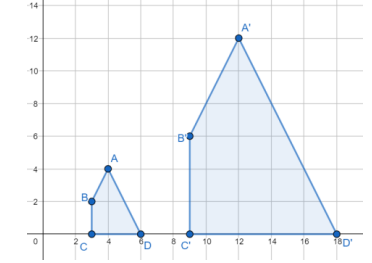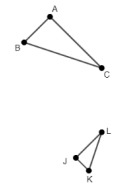General Information
Benchmark Instructional Guide
Connecting Benchmarks/Horizontal Alignment
Terms from the K-12 Glossary
- Coordinate Plane
- Dilation
- Origin
- Reflection
- Rigid Transformation
- Rotation
- Scale Factor
- Translation
Vertical Alignment
Previous Benchmarks
Next Benchmarks
Purpose and Instructional Strategies
In grade 8, students identify the scale factor of a dilation given the preimage and the image and learn that when the transformation is a dilation, this transformation does not preserve congruence. The preimage is mapped onto a scaled copy of itself. In Geometry, students determine whether two figures are similar and justify their answers using a dilation (non-rigid motion) or a sequence that includes at least one dilation. This leads to the definition of similarity in terms of dilations and rigid transformations. (MTR.5.1)- When identifying the dilation, specify the center and scale factor of the dilation.
- Instruction includes describing the transformation using words and using coordinates.
- It is important to identify corresponding parts between the preimage and the image leading to the similarity statement and the congruence of the corresponding angles and the proportionality of the corresponding sides.
- Instruction includes using examples to compare transformations. Include situations where the preimage and the image are not similar to show how dilations will fail mapping one figure onto the other. (MTR.4.1)
- When proving two triangles are similar, it is important to discuss with the students the effects of choosing which one of the triangles is the pre-image. This affects the scale factor of the dilation.
- For example, when proving that ΔABC and ΔPQR are similar, the scale factor of the dilation that maps ΔABC onto ΔPQR is , while the scale factor of the dilation that maps ΔPQR onto ΔABC is .
Common Misconceptions or Errors
- When determining the scale factor of a dilation, students may misidentify the preimage and image, leading to an incorrect scale factor.
Instructional Tasks
Instructional Task 1 (MTR.3.1)- A dilation with scale factor 3 was used to map polygon ABCD onto polygon A'B'C'D'

- Part A. Fill in the blanks with either congruent or proportional.
If the figures are similar, the corresponding sides are _______ and corresponding angles are________. - Part B. Identify the sequence of rigid and non-rigid transformations that maps polygon ABCD onto polygon A'B'C'D'.
- Part B. Use the definition of similarity to prove that polygon ABCD is similar to polygon A'B'C'D'. You may need to decompose the polygon into triangles and rectangles.
Instructional Items
Instructional Item 1- In triangles ABD and JKL,
m m m m
- Part A. Describe a sequence of transformations that maps ΔABC onto ΔJKL.
- Part B. Based on the transformations chosen, determine whether ΔABC is congruent or similar to ΔJKL.

